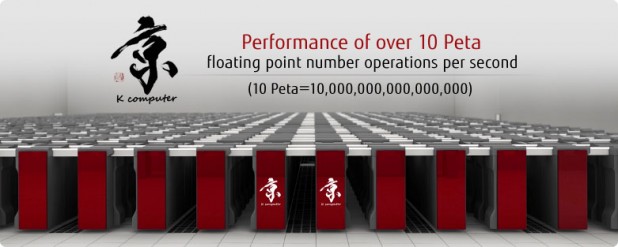 Japan wants the world's supercomputer crown.[/caption] Japan has thrown its hat into the ring for exascale computing, reported that country’s newspapers. The goal: achieve one exaflop of performance by 2020. Japan's finance ministry has agreed to begin work next fiscal year on a supercomputer with a performance capability 100 times that of the K computer, a 10 petaflop computer that debuted as the most powerful supercomputer in the world in 2011. The midterm report for the new supercomputer was concluded Thursday, the Asahi Shimbun business daily reported. The Japan Times was slightly more conservative, reporting that the Education, Culture, Sports, Science and Technology Ministry will seek funding to design the new machine in its fiscal 2014 budget request—implying that the project has not necessarily been approved. The science ministry is hoping to keep the cost of the new supercomputer below the ¥110 billion mark ($1.08 billion) that was required to develop the K computer, the paper reported. (Slashdot couldn't find any evidence that the project had been approved on the ministry Webpage, although the K computer was mentioned several times in a discussion of public-private partnerships.) Investments have already been made around the world to transform exascale into a reality, including the Mont-Blanc, CRESTA, and DEEP projects in Europe, as well as expected projects in China. However, specific funds for exascale computing were left out of the 2014 U.S. budget plan, and a fiscal 2013 budget was never formally adopted; an IDC analyst quoted by Computerworld expects the U.S. dominance in supercomputing to be overshadowed by China by 2015. As far as the cost challenges of building exascale supercomputers are concerned, there are three main ones, according to a frequently cited paper (PDF) by John Shalf, Sudip Dosanjh, and John Morrison (who hail from Lawrence Berkeley National Laboratory, Sandia National Laboratories, and Los Alamos National Laboratory, respectively). They include the cost of power, the cost of computing a FLOP, and the cost of moving data. According to the paper, the DOE adopted 20 megawatts as the upper limit for a reasonable system design, with each megawatt costing about a million dollars per year. The paper’s authors estimated that the 100W of power to supply 10 Teraflops on a chip would be dwarfed by the 2000W of power required to supply memory bandwidth to the floating-point units. The paper also suggested some avenues for power-managing the system, another key consideration. So the question that Japan needs to solve isn't just how to build an exascale computer—but how to power it. Image: Fujitsu
Japan wants the world's supercomputer crown.[/caption] Japan has thrown its hat into the ring for exascale computing, reported that country’s newspapers. The goal: achieve one exaflop of performance by 2020. Japan's finance ministry has agreed to begin work next fiscal year on a supercomputer with a performance capability 100 times that of the K computer, a 10 petaflop computer that debuted as the most powerful supercomputer in the world in 2011. The midterm report for the new supercomputer was concluded Thursday, the Asahi Shimbun business daily reported. The Japan Times was slightly more conservative, reporting that the Education, Culture, Sports, Science and Technology Ministry will seek funding to design the new machine in its fiscal 2014 budget request—implying that the project has not necessarily been approved. The science ministry is hoping to keep the cost of the new supercomputer below the ¥110 billion mark ($1.08 billion) that was required to develop the K computer, the paper reported. (Slashdot couldn't find any evidence that the project had been approved on the ministry Webpage, although the K computer was mentioned several times in a discussion of public-private partnerships.) Investments have already been made around the world to transform exascale into a reality, including the Mont-Blanc, CRESTA, and DEEP projects in Europe, as well as expected projects in China. However, specific funds for exascale computing were left out of the 2014 U.S. budget plan, and a fiscal 2013 budget was never formally adopted; an IDC analyst quoted by Computerworld expects the U.S. dominance in supercomputing to be overshadowed by China by 2015. As far as the cost challenges of building exascale supercomputers are concerned, there are three main ones, according to a frequently cited paper (PDF) by John Shalf, Sudip Dosanjh, and John Morrison (who hail from Lawrence Berkeley National Laboratory, Sandia National Laboratories, and Los Alamos National Laboratory, respectively). They include the cost of power, the cost of computing a FLOP, and the cost of moving data. According to the paper, the DOE adopted 20 megawatts as the upper limit for a reasonable system design, with each megawatt costing about a million dollars per year. The paper’s authors estimated that the 100W of power to supply 10 Teraflops on a chip would be dwarfed by the 2000W of power required to supply memory bandwidth to the floating-point units. The paper also suggested some avenues for power-managing the system, another key consideration. So the question that Japan needs to solve isn't just how to build an exascale computer—but how to power it. Image: Fujitsu Japan Planning Exascale Computer for 2020
[caption id="attachment_9696" align="aligncenter" width="618"]  Japan wants the world's supercomputer crown.[/caption] Japan has thrown its hat into the ring for exascale computing, reported that country’s newspapers. The goal: achieve one exaflop of performance by 2020. Japan's finance ministry has agreed to begin work next fiscal year on a supercomputer with a performance capability 100 times that of the K computer, a 10 petaflop computer that debuted as the most powerful supercomputer in the world in 2011. The midterm report for the new supercomputer was concluded Thursday, the Asahi Shimbun business daily reported. The Japan Times was slightly more conservative, reporting that the Education, Culture, Sports, Science and Technology Ministry will seek funding to design the new machine in its fiscal 2014 budget request—implying that the project has not necessarily been approved. The science ministry is hoping to keep the cost of the new supercomputer below the ¥110 billion mark ($1.08 billion) that was required to develop the K computer, the paper reported. (Slashdot couldn't find any evidence that the project had been approved on the ministry Webpage, although the K computer was mentioned several times in a discussion of public-private partnerships.) Investments have already been made around the world to transform exascale into a reality, including the Mont-Blanc, CRESTA, and DEEP projects in Europe, as well as expected projects in China. However, specific funds for exascale computing were left out of the 2014 U.S. budget plan, and a fiscal 2013 budget was never formally adopted; an IDC analyst quoted by Computerworld expects the U.S. dominance in supercomputing to be overshadowed by China by 2015. As far as the cost challenges of building exascale supercomputers are concerned, there are three main ones, according to a frequently cited paper (PDF) by John Shalf, Sudip Dosanjh, and John Morrison (who hail from Lawrence Berkeley National Laboratory, Sandia National Laboratories, and Los Alamos National Laboratory, respectively). They include the cost of power, the cost of computing a FLOP, and the cost of moving data. According to the paper, the DOE adopted 20 megawatts as the upper limit for a reasonable system design, with each megawatt costing about a million dollars per year. The paper’s authors estimated that the 100W of power to supply 10 Teraflops on a chip would be dwarfed by the 2000W of power required to supply memory bandwidth to the floating-point units. The paper also suggested some avenues for power-managing the system, another key consideration. So the question that Japan needs to solve isn't just how to build an exascale computer—but how to power it. Image: Fujitsu
Japan wants the world's supercomputer crown.[/caption] Japan has thrown its hat into the ring for exascale computing, reported that country’s newspapers. The goal: achieve one exaflop of performance by 2020. Japan's finance ministry has agreed to begin work next fiscal year on a supercomputer with a performance capability 100 times that of the K computer, a 10 petaflop computer that debuted as the most powerful supercomputer in the world in 2011. The midterm report for the new supercomputer was concluded Thursday, the Asahi Shimbun business daily reported. The Japan Times was slightly more conservative, reporting that the Education, Culture, Sports, Science and Technology Ministry will seek funding to design the new machine in its fiscal 2014 budget request—implying that the project has not necessarily been approved. The science ministry is hoping to keep the cost of the new supercomputer below the ¥110 billion mark ($1.08 billion) that was required to develop the K computer, the paper reported. (Slashdot couldn't find any evidence that the project had been approved on the ministry Webpage, although the K computer was mentioned several times in a discussion of public-private partnerships.) Investments have already been made around the world to transform exascale into a reality, including the Mont-Blanc, CRESTA, and DEEP projects in Europe, as well as expected projects in China. However, specific funds for exascale computing were left out of the 2014 U.S. budget plan, and a fiscal 2013 budget was never formally adopted; an IDC analyst quoted by Computerworld expects the U.S. dominance in supercomputing to be overshadowed by China by 2015. As far as the cost challenges of building exascale supercomputers are concerned, there are three main ones, according to a frequently cited paper (PDF) by John Shalf, Sudip Dosanjh, and John Morrison (who hail from Lawrence Berkeley National Laboratory, Sandia National Laboratories, and Los Alamos National Laboratory, respectively). They include the cost of power, the cost of computing a FLOP, and the cost of moving data. According to the paper, the DOE adopted 20 megawatts as the upper limit for a reasonable system design, with each megawatt costing about a million dollars per year. The paper’s authors estimated that the 100W of power to supply 10 Teraflops on a chip would be dwarfed by the 2000W of power required to supply memory bandwidth to the floating-point units. The paper also suggested some avenues for power-managing the system, another key consideration. So the question that Japan needs to solve isn't just how to build an exascale computer—but how to power it. Image: Fujitsu
 Japan wants the world's supercomputer crown.[/caption] Japan has thrown its hat into the ring for exascale computing, reported that country’s newspapers. The goal: achieve one exaflop of performance by 2020. Japan's finance ministry has agreed to begin work next fiscal year on a supercomputer with a performance capability 100 times that of the K computer, a 10 petaflop computer that debuted as the most powerful supercomputer in the world in 2011. The midterm report for the new supercomputer was concluded Thursday, the Asahi Shimbun business daily reported. The Japan Times was slightly more conservative, reporting that the Education, Culture, Sports, Science and Technology Ministry will seek funding to design the new machine in its fiscal 2014 budget request—implying that the project has not necessarily been approved. The science ministry is hoping to keep the cost of the new supercomputer below the ¥110 billion mark ($1.08 billion) that was required to develop the K computer, the paper reported. (Slashdot couldn't find any evidence that the project had been approved on the ministry Webpage, although the K computer was mentioned several times in a discussion of public-private partnerships.) Investments have already been made around the world to transform exascale into a reality, including the Mont-Blanc, CRESTA, and DEEP projects in Europe, as well as expected projects in China. However, specific funds for exascale computing were left out of the 2014 U.S. budget plan, and a fiscal 2013 budget was never formally adopted; an IDC analyst quoted by Computerworld expects the U.S. dominance in supercomputing to be overshadowed by China by 2015. As far as the cost challenges of building exascale supercomputers are concerned, there are three main ones, according to a frequently cited paper (PDF) by John Shalf, Sudip Dosanjh, and John Morrison (who hail from Lawrence Berkeley National Laboratory, Sandia National Laboratories, and Los Alamos National Laboratory, respectively). They include the cost of power, the cost of computing a FLOP, and the cost of moving data. According to the paper, the DOE adopted 20 megawatts as the upper limit for a reasonable system design, with each megawatt costing about a million dollars per year. The paper’s authors estimated that the 100W of power to supply 10 Teraflops on a chip would be dwarfed by the 2000W of power required to supply memory bandwidth to the floating-point units. The paper also suggested some avenues for power-managing the system, another key consideration. So the question that Japan needs to solve isn't just how to build an exascale computer—but how to power it. Image: Fujitsu
Japan wants the world's supercomputer crown.[/caption] Japan has thrown its hat into the ring for exascale computing, reported that country’s newspapers. The goal: achieve one exaflop of performance by 2020. Japan's finance ministry has agreed to begin work next fiscal year on a supercomputer with a performance capability 100 times that of the K computer, a 10 petaflop computer that debuted as the most powerful supercomputer in the world in 2011. The midterm report for the new supercomputer was concluded Thursday, the Asahi Shimbun business daily reported. The Japan Times was slightly more conservative, reporting that the Education, Culture, Sports, Science and Technology Ministry will seek funding to design the new machine in its fiscal 2014 budget request—implying that the project has not necessarily been approved. The science ministry is hoping to keep the cost of the new supercomputer below the ¥110 billion mark ($1.08 billion) that was required to develop the K computer, the paper reported. (Slashdot couldn't find any evidence that the project had been approved on the ministry Webpage, although the K computer was mentioned several times in a discussion of public-private partnerships.) Investments have already been made around the world to transform exascale into a reality, including the Mont-Blanc, CRESTA, and DEEP projects in Europe, as well as expected projects in China. However, specific funds for exascale computing were left out of the 2014 U.S. budget plan, and a fiscal 2013 budget was never formally adopted; an IDC analyst quoted by Computerworld expects the U.S. dominance in supercomputing to be overshadowed by China by 2015. As far as the cost challenges of building exascale supercomputers are concerned, there are three main ones, according to a frequently cited paper (PDF) by John Shalf, Sudip Dosanjh, and John Morrison (who hail from Lawrence Berkeley National Laboratory, Sandia National Laboratories, and Los Alamos National Laboratory, respectively). They include the cost of power, the cost of computing a FLOP, and the cost of moving data. According to the paper, the DOE adopted 20 megawatts as the upper limit for a reasonable system design, with each megawatt costing about a million dollars per year. The paper’s authors estimated that the 100W of power to supply 10 Teraflops on a chip would be dwarfed by the 2000W of power required to supply memory bandwidth to the floating-point units. The paper also suggested some avenues for power-managing the system, another key consideration. So the question that Japan needs to solve isn't just how to build an exascale computer—but how to power it. Image: Fujitsu 

